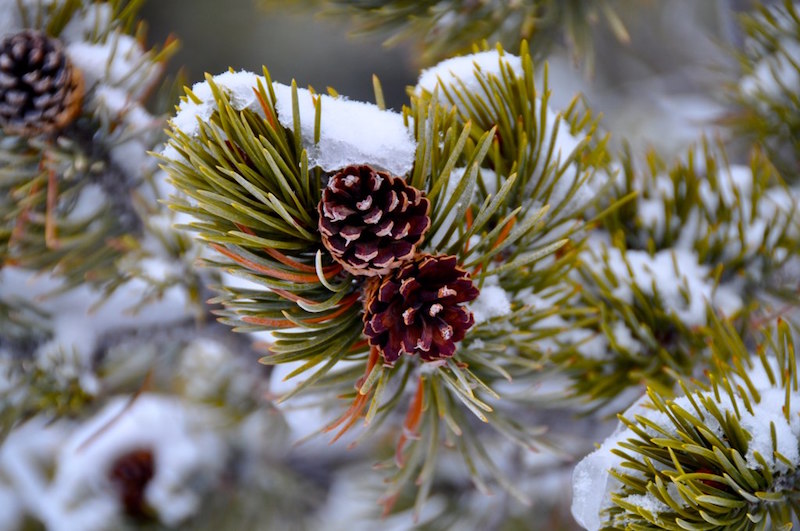This time of year, the question is almost always asked. Is a real or artificial Christmas tree the most environmentally responsible?
There are many reasons why real Christmas trees are more eco-friendly. Real trees are both a renewable and biodegradable natural resource. On average, it takes about seven years to raise a Christmas tree to marketable size. During that time, it is absorbing carbon dioxide and filtering the air of particulate matter and releasing oxygen. It is also providing watershed protection and habitat for birds and other wildlife. Christmas trees are planted and raised as a crop by tree farmers. Unlike other row crops, a Christmas tree plantation remains green and growing year-round. If there was no market for real Christmas trees, that land would probably be developed for something else. For every Christmas tree that is harvested nationally, two to three seedlings are planted.
To make your choice even more sustainable, select a tree from a local Christmas tree farm instead of purchasing one from a big-box store that trucks them in from across the country. There are many local tree farms that can be found near Kansas City, nationwide and beyond at Pick Your Own Christmas Tree.
In contrast, artificial Christmas trees are made primarily of metals and plastics, which are all non-renewable resources. The plastic material, typically polyvinyl chloride (PVC), is a potential source of lead. The potential for lead poisoning is considered high enough that California requires a warning label on all artificial trees made in China, and an estimated 85 percent of artificial trees are made in China. Additionally, these trees must be transported 8,000-plus miles to their U.S. destination, which emits additional CO2.
On average, an artificial tree is used for seven years before it ends up in the landfill. So, if a tree is displayed for one month per year, that means it will have been used for a total of seven months, and will remain in a landfill indefinitely. Even if it were to be used for 20 holiday seasons, it’s still going to end up in a landfill far longer. In contrast, a real tree can be composted, submerged in ponds for fish habitat or made into wood chips.
If you don’t want to cut a tree, another good option is to buy a live tree to plant in your yard after the holidays. A live tree will require more care and will only be able to be in the house for a few days. It’s best to dig a hole before the ground freezes, and then be prepared to plant it the day after Christmas.
If someone in your family is allergic to evergreen trees, and you can’t imagine Christmas without a tree, another choice is to purchase a used, artificial tree from a thrift store, and save it from the landfill for a few more years. When the tree is no longer usable, the branches can be cut and repurposed into other decorations like swags, wreaths and garland, further delaying its final destination.
Photo: DevonshireMedia / CC

These are great points. My family always had a real tree. Most years when I was younger we would drive out of town (Toronto) to a tree farm to choose and cut down a tree. We liked to joke that “in the spirit of the season, we went out and killed a tree.” I suppose one must include the CO2 from that trip as well. In recent years we have used an artificial tree that was purchased when money was tight (it is small and very cheaply made), and I realize today it’s now almost 20 years old! It has great sentimental value, and we already own it; but it’s nice to know that my craving for a real tree can be satisfied again some day without too much of a guilty conscience.
30 years ago, we were being told to use artificial trees and plastic bags at the grocery store To saves trees. …..
THANK YOU Greenability team for researching and articulating this question in deep-Green detail!
We will link to your Green-savvy from the Missouri Botanical Garden’s holiday blog, with sincere appreciation.
Jean Ponzi
Green Resources Manager
EarthWays Center of the Missouri Botanical Garden
St. Louis, MO
Thank you for your wonderful article on live verses artificial trees. I might add that a tree gives off more oxygen in its early growing years so they are even more beneficial in their short life. For those who have allergies, I would encourage you to try a white pine, maybe just a few branches the first year, to see if you react to that. White pine tend not to have any fungal spores and that is often what causes the allergies. We have grown trees for Christmas trees now for 35 years! It is often challenging with varying weather conditions but certainly great fun to see families return year after year to find their special tree. We now are into our second and some third generations coming to the farm.
Carol Freeman
Christmas Ranch Tree Farm